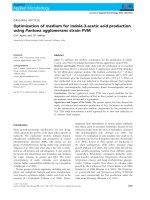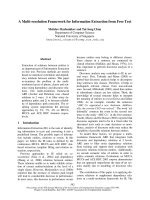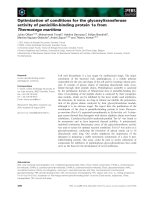Optimization of conditions for carotenoid extraction from shrimp waste using organic solvent
Bạn đang xem bản rút gọn của tài liệu. Xem và tải ngay bản đầy đủ của tài liệu tại đây (284.05 KB, 7 trang )
Vietnam Journal of Science and Technology 57 (3B) (2019) 42-48
doi:10.15625/2525-2518/57/3B/14111
OPTIMIZATION OF CONDITIONS FOR CAROTENOID
EXTRACTION FROM SHRIMP WASTE USING ORGANIC
SOLVENT
Le Thanh Ha* , Le Duy Thang
School of Biotechnology and Food Technology, Hanoi University of Science and Technology,
1 Dai Co Viet, Hai Ba Trung, Ha Noi
*
Email:
Received: 5 August 2019; Accepted for publication: 3 November 2019
Abstract. In this study, factors affecting the extraction yield of carotenoids from dried shrimp
waste by organic solvents have been studied. The results showed that the solvent ratio hexane:
acetone = 3: 1 gave the highest carotenoid yield. At this ratio of solvent’s mixture, the
carotenoid yield reached highest at temperature 60 C after 2 hours extraction, which was 44.64
µg/g raw shrimp waste (d.b.) (ratio of solvent to raw material 3/1). Ultrasound or vortexing gave
higher extraction yield than in static conditions, which was 1.8- fold to 1.5- fold increase,
respectively. At the ratio of solvent: dried shrimp waste = 4: 1, the amount of carotenoids
recovered at 60 C for 2 hours with vortexing increased to 57.4 µg/g. However, if the shrimp
waste was hydrolyzed with Alcalase at 50 C for 4 hours before extraction by solvent, the
amount of recovered carotenoids achieved 148.8 µg/g of raw material.
Keywords: Alcalse, Carotenoids, Penaeus vannamei, shrimp waste, extraction.
Classification numbers: 1.3.1, 1.5.1
1. INTRODUCTION
Viet Nam is the world's third largest shrimp producer. Shrimp production reached 762,000
tones in 2018, which was 6.3 % increase compared to 2017. According to forecasting of
Vietnam's seafood exportation, the shrimp production will be approximately 900 thousand tons
by 2020; 1.5 million tons by 2030. The processed shrimp generates an industrial waste which
accounts up to 40 to 50 % (w/w) of raw material. As a result, an estimated 350,000 tons (wet
weight) of shrimp waste is released per year. The shrimp waste can be used to obtain
carotenoids, which are bioactive substances highly demanded by the food and pharmaceutical
industries. The carotenoids attracted interest of many researchers due to their natural origin,
null toxicity and high versatility.
Carotenoids could be extracted from shrimp waste by organic solvent. A 50:50 mixture of
isopropyl alcohol and hexane gave the highest (43.9 µg/g waste) extraction yield of carotenoids
compared to acetone, methanol, ethanol, isopropyl alcohol, ethyl acetate, ethyl methyl ketone,
petroleum ether, hexane individually and to a 50:50 mixture of acetone and hexane
[1]. Vegetable oils have also been successfully used as solvents for the extraction of carotenoid
Optimization of conditions for carotenoid extraction from shrimp waste using organic solvent
components from vegetal sources and crustaceans. Sachindra et al. [2] reported that the
carotenoid recovery yield in shrimp waste with different oils were from 16.1 µg/g to 26.1 µg/g
waste, which was much lower than that with organic solvent. In recent years, supercritical CO2
(SC - CO2) has been used as an alternative method for carotenoid extraction. The extracting
yield was low due to their low solubility in supercritical CO2 [3] and an economical constraint
due to the high investment cost inherent to high pressure processes [4]. Proteolytic hydrolysis
has been used for recovery of carotenoids from shrimp waste and had positive effect on the
carotenoid yield [5, 6].
Many studies on extraction of carotenoids from fresh shrimp waste were reported.
According to Trang study, the carotenoids yield from fresh shrimp waste decrease 28.3 % after
1 month storing even during cold storage at -20 C [7]. Mezzomo reported in his study, that the
extracted yield of carotenoids from dried shrimp waste increased in comparison to fresh shrimp
waste [8]. Therefore, drying could be alternative storage to cold storage. The aim of this study is
to find the optimum condition for carotenoid extraction from dried shrimp waste.
2. MATERIALS AND METHODS
2.1. Materials
The raw material consists of whiteleg shrimp (Penaeus vannamei) waste, composed
essentially by head and carpace. The protein contents, ash contents and moisture contents of raw
material were 12.07 ± 0.21 %, 4.26 ± 0.22 %, and 77.87 ± 0.46 %, respectively. The residues
were provided by Hai Phong seafood export company Ltd, Hai Phong, Vietnam. The fresh
shrimp residues after processing were directly transported to laboratory under iced conditions
and were stored at -20 C for subsequent use.
2.2. Method
2.2.1. Pre-treatment of shrimp waste
The shrimp waste was submitted to the following pretreatments: a) drying with subsequent
grinding b) cooking with subsequent drying and grinding; c) proteolytic hydrolysis.
For cooking, the raw material was submitted to a quick cooking in a heating bath with
water at 100 oC for 10 min. For drying, the shrimp waste was dried at 60 oC for 5 h in an oven
with air circulation. The moisture content of died shrimp waste was 4.5 %. For grinding, the
dried shrimp waste was grinded in a domestic blender for 2 minutes. For proteolytic hydrolysis,
the samples were kept at 50 oC with addition of water at ratio 1/2 (w/v) and Alcalse at ratio
0.5 % (w/w). After hydrolysis, the samples was filtered to collect the filtrate and residues. The
filtrate was centrifuged. The precipates containing carotenoids was separated and extracted with
mixture of 3 hexane and 1 acetone at ratio 4/1 with 2 repeated cycles. The residues after
filtration was dried and used for extraction according to procedure as for dried shrimp waste
without enzymatic pretreatment.
2.2.2. Solvent extraction of carotenoids
The total carotenoids (as astaxanthin) were extracted using a mixture of acetone and hexane
with the ratio of solvent: shrimp waste 3/1 (v/w). The ratio of hexane: acetone in the mixture
43
Le Thanh Ha, Le Duy Thang
was varied from 1 : 2, 1 : 1, 1 : 2, 1 : 3 and 1 : 4. The temperature of extraction mixture were
kept at 40, 50, 60 and 70 oC for two hours with or without vortexing. For extraction, 2 grams of
shrimp waste were used. The extraction was caried out with 2 repeated cycles. Each experiment
was done in triplicate.
2.2.3. Quantification of carotenoids
After extraction, the mixture was centrifuged to collect the supernatant. Then 1 ml
supernatant was dried by evaporation to remove the solvent and the residues were resuspended
in 2.5 ml mixture of hexane and acetone at ratio 3:1. The amount of the carotenoids, reported as
astaxanthin, was quantified by absorbance measurement at 470 nm using Astaxanthin at
concentration from 1 g/mL to 8 g/mL (Sigma) as standard [1].
2.2.4. Identification of astaxanthin by thin layer chromatography (TLC)
The extracted carotenoids in supernatant were visualised by TLC according to Dalei and
Sahoo with small modification. For this, a small volume of the extract was spotted on silica gel
plate and developed using acetone: hexane 1:3 (v/v) [9]. The separated bands were identified
using standard astaxanthin (Sigma).
3. RESULTS AND DISCUSSION
3.1. Optimization conditions for carotenoid extraction
According to Sachindra, the mixture of polar and non-polar solvent is beneficial since the
polar solvents remove the water in tissues which will aid in the extractability of pigments in
nonpolar solvents in subsequent extractions [1]. However the lower carotenoid yield in the
mixture of hexane: acetone at ratio 1/1 was observed than in the mixture of isopropanol: hexane
at the same ratio (38.5 g/g compared to 43.9 g/g). In this study, the ratio of hexane to acetone
(v/v) were varied as of 1/1, 1/2, 1/3 and 1/4. The ratio of solvent to sample was kept 3/1 (v/w).
The samples were pretreated by drying and milling. The extraction was carried out at 60 C for 2
hours with vortexing every 15 min with three repeated cycles. The extracted carotenoids were
quantified (Table 1).
Table 1. Effect of ratio hexane/acetone on the carotenoid yield.
Ratio
hexane/acetone
1: 2
1: 1
2: 1
3: 1
4: 1
Carotenoid yield
(g astaxanthin/g waste d.b)
33.64 ± 4.76
34.36 ± 6.96
37.53 ± 0.87
44.90 ± 0.16
44.10 ± 17.20
The carotenoid yield increased when the ratio of hexane increased from 33 % to 75 %
(corresponding to ratio hexane: acetone from 1/2 to 3/1). If ratio hexane to acetone increased
further to 80 %, the slight decrease of carotenoid yield was observed. According to Sachindra,
the hexane ratio for optimal extraction yield of carotenoids from fresh shrimp waste was 60%
44
Optimization of conditions for carotenoid extraction from shrimp waste using organic solvent
[1]. The higher ratio of hexane 75 % in this study could be explained by lower water content of
dry waste requires lower ratio of polar solvent acetone. Thus the ratio 3/1 was chosen for the
next experiment. Compared to a reported study [1], the carotenoid yield of 44.9 g/g from dried
shrimp waste was reasonable.
In the next experiment the effect of extraction temperature, duration of extraction was
investigated. Elevation of extraction temperature from 40 C to 60 C resulted in increase of
carotenoid yield from 38.2 g/g to 44.3 g/g. Almost no increase of yield was observed at
higher extraction temperature of 70 C (Figure 1 A). Therefore, extraction temperature of 60 C
was chosen. The extraction yield showed optimal at extraction temperature of 70 C when
extracting shrimp waste by sunflower oil [2]. The extraction yield was increased from 35.4 g/g
to 44.5 g/g when extraction time increased from 1 hour to 2 hours. Prolonging extraction time
to 3 hours resulted in insignificant increase in yield (Figure 1 B). Thus two hours of extraction
was optimal. Optimal carotenoid yield was found at extraction time of 150 min by Sachindra
when using sunflower oil for extraction [2].
Figure 1. The effect of extraction temperature (A), extraction time (B) on extracted carotenoids yield.
Figure 2. The effect of mixing (A) and ratio solvent/shrimp waste (B) on extracted carotenoids yield.
Mixing had strong effect on the carotenoid yield, where higher yield was achieved at the
better mixing situation, indicating by frequency of vortexing. Mixing accelerates the diffusion
and thus elevated mass transfer coefficient, leading to higher extraction yield. The yield could be
1.5 fold increased by vortexing every 15 min compared to no vortexing. However sonication
gave the highest yield, reaching 52.4 g/g, probably not only due to better mixing but might be
due to enhancement of removing of carotenoids from shrimp shells (Figure 2A) [10].
The effect of ratio solvent to material was also studied (Figure 2B). The ratio of liquid to
solid was varied from 2/1, 3/1, 4/1 to 5/1 (v/w). The higher ratio of solvent to material, the
higher extraction yield. The yield was almost twofold increase when ratio of solvent doubled
45
Le Thanh Ha, Le Duy Thang
from 2/1 to 4/1. However, the increase of ratio from 4/1 to 5/1 resulted in almost no increase of
the yield. Therefore, the ratio of solvent to dried shrimp waste of 4/1 was optimal, giving
carotenoid yield 57.4 g/g. Sachindra found the optimal ratio of solvent to wet shrimp waste 5/1,
a bit higher than dried shrimp waste [1]. Therefore, using dried shrimp waste could reduce a
large volume of solvent due to reduction of water content and due to lower ratio of solvent to
material.
3.2. Effect of pretreatment method
Firstly, the effect of cooking on extracted carotenoid yields was studied. After cooking, the
shrimp waste was dried and grinded according to protocol. The results from Figure 3 showed
that the sample with cooking gave lower yield (1.2- fold decrease from 45.4 g/g to 37.3 g/g).
This was similar to the results reported by Mezzomo, who found the cooking resulted in
decrease of extraction yield almost 1.24 times [8]. This could be explained by the releasing of
carotenoids in the water, probably due to activating enzyme in shrimp waste. The red color of
the cooked water confirmed this hypothesis. However, according to Mezzomo, although the
extraction yield by cooking decreased 1.24 times, the total carotenoid content per gram extract
increased 1.26 times. The authors suggested that the cooking process can break the carotenoid–
protein complex, releasing the carotenoid compounds and facilitating its extraction.
Figure 3. The effect of cooking on extracted carotenoids yield.
In the next experiment the effect of proteolytic hydrolysis time on extracted carotenoid
yield was studied. Alcalase was used for this experiment. It could be seen that prolonging
hydrolysis time resulted in higher carotenoid yield (Table 2).
The carotenoids in shrimp waste exit in the form of carotenoid–protein complex. Therefore,
protease will hydrolyze this complex and release the carotenoids, facilitate extraction, leading to
increase of carotenoid yield. The increase of carotenoid yield by proteolytic hydrolysis was
reported also in [5]. Prolonging hydrolysis time to five hours, however, decreased the yield,
probably due to degradation (Table 2). The increase of carotenoid yield was also observed when
hydrolysis time prolonged from 3 to 5 hours by Chakrabarti [11]. Compared to the dried shrimp
waste sample without hydrolysis, the carotenoid yield from fresh shrimp with hydrolysis was 2.6
fold increase (148.8 g/g compared to 57.4 g/g) (Table 2). It could be seen from Table 2, the
carotenoid content almost removed from shrimp shells into the filtrate after only one hour of
hydrolysis, remained at very low level in the residues. However, the hydrolysis of carotenoidprotein complex in filtrate continued, releasing carotenoid maximum at 4 hours of hydrolysis.
The results of Table 2 also suggested that the extraction of carotenoids from residues could be
skipped out, since their carotenoid contents accounted for only less than 6.6 % of total extracted
carotenoids.
46
Optimization of conditions for carotenoid extraction from shrimp waste using organic solvent
Table 2. Effect of time of enzymatic hydrolysis on the carotenoid yield.
Hydrolysis time
(hours)
1
2
3
4
5
Carotenoid yield
(g astaxanthin/g waste d.b)
In filtrate
In residues
94.12
10.40
121.88
10.96
132.47
9.94
139.06
9.73
106.07
10.19
Total
104.52
132.85
142.41
148.80
116.26
The presence of astaxanthin in extract was confirmed by TLC (Figure 4). The results
suggested that free astaxanthin was the major pigment in extracted carotenoids from dried
shrimp waste of Penaeus vannamei. In contrast in marine shrimp Penaus semisulcatus,
astaxanthin esters were the major carotenoids [12]. The components of carotenoids in extracts
was reported to depend on type of shrimp, extraction method and TLC method [9, 12].
Figure 4. Chromatogram of extracted carotenoids from dried shrimp waste at ratio
hexane: acetone 2:1 (1) and 3:1 (3), (2) Astaxanthin standard (Sigma).
4. CONCLUSION
The optimal conditions for astaxantin extraction from dried shrimp waste were using
mixture of hexane and acetone at ratio 3/1, extraction temperature of 60 C, extraction time of 2
hours, and ratio of solvent to dried shrimp waste 4/1. Ultrasound and vortexing positive resulted
on extracted carotenoid yield. The extracted carotenoid yield decreased 1.2-fold by cooking
pretreatment. Meanwhile the enzymatic hydrolysis could increase the extracted carotenoid yield
up to 2.6-fold, reaching 148.8 g/g raw material.
REFERENCES
1.
Sachindra N. M., Bhaskar N., and Mahendrakar N. S. - Recovery of carotenoids from
shrimp waste in organic solvents, Waste Management 26 (10) (2006) 1092-1098.
2.
Sachindra N. M. and Mahendrakar N. S. - Process optimization for extraction of
carotenoids from shrimp waste with vegetable oils, Bioresource Technology 96 (10)
(2005) 1195-1200.
3.
Sánchez-Camargo A. P., Martinez-Correa H. A., Paviani L. C., and Cabral F. A. Supercritical CO2 extraction of lipids and astaxanthin from Brazilian redspotted shrimp
47
Le Thanh Ha, Le Duy Thang
waste (Farfantepenaeus paulensis), The Journal of Supercritical Fluids 56 (2) (2011) 164173.
4.
Mezzomo N., Martínez J., Maraschin M., and Ferreira S. R. S. - Pink shrimp (P.
brasiliensis and P. paulensis) residue: Supercritical fluid extraction of carotenoid fraction,
The Journal of Supercritical Fluids 74 (2013) 22-33.
5.
Babu C. M., Chakrabarti R., and Surya Sambasivarao K. R. - Enzymatic isolation of
carotenoid-protein complex from shrimp head waste and its use as a source of carotenoids,
LWT- Food Science and Technology 41 (2) (2008) 227-235.
6.
Lee S., Roh S., Park K., and Yoon K. R. - Effective extraction of astaxanthin pigment
from shrimp using proteolytic enzymes, Biotechnology and Bioprocess Engineering 4 (3)
(1999) 199-204.
7.
Trang S. T., Vu L. Q., and Huynh N. D. B. - Effect of storage time and temperature on the
moisture, protein and astaxantine in shrimp heads, Journal of Fisheries Science and
Technology 4 (2015) 78-84 (in Vietnamese).
8.
Mezzomo N., Maestri B., dos Santos R. L., Maraschin M., and Ferreira S. R. S. - Pink
shrimp (P. brasiliensis and P. paulensis) residue: Influence of extraction method on
carotenoid concentration, Talanta 85 (3) (2011) 1383-1391.
9.
Dalei J. and Sahoo D. - Extraction and characterixation of astaxanthin from the
crustacean shell waste from shrimp processing industries International Journal of
Pharmaceutical Sciences and Research 6 (6) (2015) 2532-2537.
10. Kjartansson G. T., Zivanovic S., Kristbergsson K., and Weiss J. - Sonication-Assisted
Extraction of Chitin from Shells of Fresh Water Prawns (Macrobrachium rosenbergii),
Journal of Agricultural and Food Chemistry 54 (9) (2006) 3317-3323.
11. Chakrabarti R. - Carotenoprotein from tropical brown shrimp shell waste by enzymatic
process Food Biotechnology 16 (1) (2002) 81-90.
12. Khanafari A., Saberi A., Azar M., Nosooghi G., Jamili S., and Sabbaghzadeh B. Extraction of astaxanthin esters from shrimp waste by chemical and microbial methods,
Iranian Journal of Environmental Health Science & Engineering 4 (2) (2007) 93-98.
48









